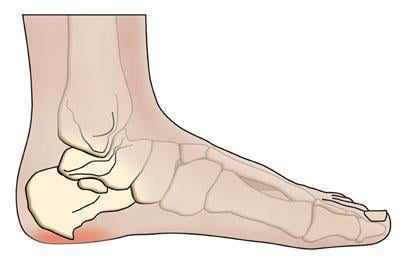Heel Spur Treatment, Symptoms, Causes and Prevention
What is the difference between a Heel Spur and Plantar Fasciitis?
A Heel spur is a bony overgrowth on the bottom of the heel bone that results from tension and inflammation in the plantar fascia attachment to the heel.
Heel spur syndrome may be described as the combination of plantar fasciitis, tendonitis or stress with or without a plantar heel spur. Heel spur syndrome affect women more than men. They can cause the bottom of the heel and arch to become painful.

Plantar fasciitis is an inflammation of the long band of connective tissue running from the heel to the ball of the foot. (read more about plantar fasciitis...)

Heel Spur Symptoms
What are the symptoms of a heel spur?
Symptoms of heel spurs can occur suddenly or gradually. When they occur suddenly, there is usually intense heel pain on taking the first morning steps, known as first-step pain. This heel pain often subsides as the patient begins to walk around, but it may return in the late afternoon or evening.
When symptoms occur gradually, a more chronic form of bone spur heel pain causes patients to shorten their stride while running or walking. Patients also may shift the weight toward the front of the foot, away from the heel.
Heel Spur Causes
What causes Heel Spurs?
Some people tend to have a naturally dry skin that predisposes them to the cracks. The thickened dry skin (callus) around the heel that is more likely to crack is often due to mechanical factors that increase pressures in that area (eg the way you walk). Other factors that can be involved in the cause of cracked heels include:
- Stretching the long band of tissue that connects the heel and the ball of the foot
- Muscle imbalance
- Bone deformity
- Obesity
- Trauma
- Tightness of the muscles on the back of the leg
Heel Spur Prevention
How to prevent Heel Spurs?
- Warm up and stretch properly before exercise
- Wear appropriate shoe gear
- "RICE" - rest, ice, compression, and elevation
Heel Spur Treatment
How To Treat Heel Spurs?
- Wearing proper footwear for both everyday and sporting activities can provide heel spur relief.
- Using insoles that support the arch and reduce tension on the ligament help with heel spur pain.
- Making use of an arch brace, arch bandage or arch cradle to relieve pressure and reduce inflammation of the plantar fascia at its attachment to the heel bone.
- Giving the afflicted area an ice massage to reduce inflammation and relieve tension.
- Stretching calf muscle to reduce tightness.
Links to recommended PediFix® Products:





